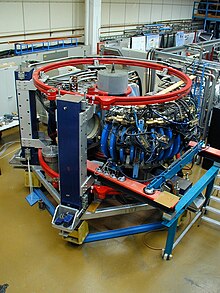WEGA plasma experiment
WEGA ( W endelstein E xperiment in G mature forest for the A ducation) was an experiment for magnetic confinement of plasmas after stellarator principle, which from 2001 to 2013 at the Max Planck Institute for Plasma Physics in Greifswald for forming the scientists and engineers as well as for testing diagnostics and experiment control for the Wendelstein 7-X stellarator . The main scientific topics were investigations into the wave heating of overdense plasmas through mode conversion and turbulence.
WEGA was originally designed as a hybrid experiment that could be used both as a tokamak - with a toroidal current flowing in the plasma - and as a stellarator . To operate as a stellarator, helical magnetic field coils were available, which could generate the necessary twisting of the magnetic field lines . At the Center d'Etudes Nucléaires in Grenoble (1972–1982), WEGA was initially used primarily as a tokamak to investigate plasma heating processes. Then (1982–2000) the experiment was a stellarator at the Institute for Plasma Research at the University of Stuttgart until it was taken over in 2000 by the Max Planck Institute for Plasma Physics in Greifswald. In 2014, the system was dismantled and passed on to the Center for Plasma Material Interactions at the University of Illinois at Urbana-Champaign , where it is used as a " Hybrid Illinois Device for Research and Applications " (HIDRA) primarily to explore the plasma-wall interaction.
Components and technical data
The WEGA plasma vessel consists of a stainless steel torus with a large 72 cm radius and a small 19 cm radius. The large number of 100 vacuum ports are used for plasma operation, pumps, gas inlet and heating with microwaves as well as for a variety of diagnostics. The magnetic field to contain the stellarator plasma is generated by four types of copper coils, which allow many magnetic configurations to be investigated. Forty toroidal field coils generate the main field, two helically twisted coils generate the helical twisting necessary for the plasma confinement in this stellarator. Two pairs of poloidal field coils allow the plasma to be shifted outwards or inwards. There is also a special coil with which asymmetries in the magnetic field can be generated or compensated. The small radius varies significantly with the selected magnetic configuration; at its maximum value a = 11 cm, the enclosed plasma has a volume of 0.16 m³. Working gases in WEGA were helium, argon and hydrogen. With sufficiently low currents and thus low magnetic fields, stationary plasmas were generated, limited in time by the temperature rise in the coils. With a slightly higher magnetic field of B = 0.5 Tesla, quasi-stationary operation of around 15 s is achieved before the coils get too warm.
Microwave transmitters with a heating power of 26 kW and 10 kW at frequencies of 2.45 GHz and 28 GHz were available for plasma heating. This enabled electron temperatures of 10 to 50 eV and ion temperatures of 1 to 5 eV to be achieved. At these moderate temperatures, the plasmas are not yet fully ionized, but there are also neutral gas atoms. The densities of the released electrons are 10 17 to 10 18 m −3 . In so-called overdense plasmas, where penetration of the microwave is only possible through a complex conversion process, up to 10 19 m −3 was reached. The latter is about a tenth of what is aimed at in a tokamak fusion experiment.
Individual evidence
- ↑ WEGA | Max Planck Institute for Plasma Physics ( Memento from March 24, 2019 in the Internet Archive )
- ^ Rabel Rizkallah et al .: Latest Results From the Hybrid Illinois Device for Research and Applications (HIDRA). IEEE Transactions on Plasma Science 46, 2018, doi: 10.1109 / TPS.2018.2838571 ( free full text ).
- ↑ WEGA, Technical Data | Max Planck Institute for Plasma Physics ( Memento from March 24, 2019 in the Internet Archive )
Web links
- Website of the Max Planck Institute for Plasma Physics on WEGA
- Summary of key results
- MPG research report 2014
- Hidra Core Assembly on YouTube - Time-lapse video of the assembly in Illinois
